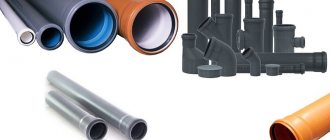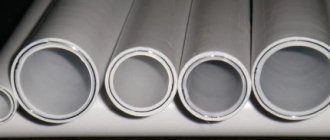Replacing leaky toilet pipes yourself is not easy, but it is possible. The main problems here arise from the cramped space in the bathroom. Many owners do not want to get rid of the old toilet, but replacing pipes in a toilet with already installed plumbing is still a pleasure.
We will tell you all about the rules and specifics of replacing communications in the bathroom. We'll tell you what materials an independent home craftsman will need to stock up on. The article we presented describes in detail the replacement technology and provides useful recommendations, adherence to which will ensure the quality of the assembly.
Stages of preparatory work
Like any household work, replacing old sewer pipes will be faster and more efficient if you evaluate the work in advance, draw up a plan and carry out thorough preparation. The entire volume can be divided into several stages.
Planning and purchasing materials
Due to the fact that in this case the sewerage system will not be installed from scratch, but only the pipes will be replaced, design work can be simplified. However, they must be carried out in two cases:
- it is planned to change the design of the engineering system, taking into account the shortcomings of the previous version;
- new consumers need to be added.
If the system functioned successfully, experts recommend laying pipes along the old route and using existing technological holes in the partitions.
Before replacing a sewer pipe, it is necessary to clarify the number and nature of water intake points in the apartment or house. They are: household appliances, namely washing machines, dishwashers, sinks, toilets, bidets and others.
In this case, it is easier to purchase materials. When compiling a shopping list at a building materials store, you will also need measurements of the old pipeline and a census of the fittings used. Naturally, new sewer pipes and fittings will be qualitatively different than dismantled ones, since the industry for their production is rapidly developing, offering more and more effective solutions, but the quantitative volume will be the same. You just need to provide a certain reserve.
Pipe measurements
Today, polymer pipes are mainly used for sewer installation; steel pipes are less commonly found, the installation of which is associated with certain difficulties.
Dismantling
When the old system has been studied and the places that need to be changed have been specified, you can begin to dismantle it. Basic rules for dismantling:
- It begins with the fact that furniture and household appliances that may interfere and are subject to the possibility of being damaged are removed from the premises.
- First turn off the water supply and also disconnect the hose that leads to the toilet flush tank.
- Old sewer pipes are cut into fragments using a grinder and taken out of the apartment or house.
- If the place where the pipe runs is far from the riser, and you can’t get there with a grinder, you can simply break it with a hammer or sledgehammer, since cast iron is quite fragile.
Sewage dismantling
Installation of internal wiring
After installing the riser, it is necessary to change the internal wiring in the apartment. The work rules include the following recommendations:
- The wiring is carried out from the central riser to the plumbing fixtures (toilet, sink).
- It is necessary to install not only rigid, but also moving elements of the pipeline. Moving elements made of corrugated pipes relieve the internal stress of the system.
- The sockets should be positioned towards the flow of wastewater, this reduces the risk of leakage.
- The sewage system must be installed at a slope towards the drainage direction.
- A pipe with a diameter of 110 mm is used to drain water from the toilet.
- For all other plumbing fixtures, a 50mm diameter pipe must be used.
After installing the wastewater disposal system, the drain tank is connected and a test run is performed. The correct operation of the flush tank depends on the correct connection to the toilet and the tightness of the connection with the supply pipe. There are also cistern models that need to be mounted to the wall. All necessary components for installation are usually supplied with the equipment. Also, the cistern device can be hidden inside a plasterboard structure, which will add aesthetics to the restroom room.
Compliance with simple recommendations for laying a drainage network guarantees the reliable operation of all plumbing fixtures in the apartment, the absence of leaks, extraneous noise and odors. If difficulties arise when carrying out the work yourself, you can call qualified specialists.
Diameter selection
Before purchasing building material, it is necessary to calculate the volume of waste water produced by water consumers. It is not recommended to save money by buying an inexpensive product with a narrow cross-section.
The recommended drain diameter in the wiring diagram is taken as follows:
- riser in the restroom - 100-125 mm;
- outlet from the bathtub and shower cabin - 50 mm;
- toilet and bidet drain - 100 mm;
- outlet from the kitchen sink - 50-70 mm;
- dishwasher and washing machine outlet - 32 mm.
For installation of external sections, only rigid pipes that can withstand strong mechanical loads are required.
How to dismantle a cast iron pipe
If a pipe is “welded” to a wall or floor using sulfur or aluminum, it will be very, very difficult to destroy such a coating.
To get started, you must first turn off the water supply to the apartment. Then you need to free the bathroom from unnecessary items that you can damage during work. This includes the sink, washing machine, laundry basket, etc.
Next, you need to disconnect the flush tank from the water supply and dismantle the toilet itself. Problems may also arise here, since Soviet toilets were screwed to the floor conscientiously, in other words, tightly.
Try to unscrew the bolts that attach the toilet to the floor and remove it from its place. If you succeed, consider yourself half done.
Now comes the turn of the pipes themselves. Cast iron, as you know, is not particularly strong, so at some distance from the riser you can simply break the old pipe with a hammer. It is much more difficult to remove the remains of pipes from the old riser and clean them before installing new ones.
To dismantle pipes, you may need:
- A hammer with a rubber or plastic tip.
- Chisel
- Torch or blowtorch
- Mask
Quite a strange combination, isn't it? However, a gas mask is necessary to comply with safety precautions if the joints of sewer pipes in your bathroom are filled with sulfur.
The easiest way to remove sulfur is by heating it. However, when heated, the sulfur mass releases toxic substances into the air, which are extremely harmful for humans to inhale. That is why it is better to protect yourself with a gas mask in advance.
So, dismantling must begin at the point of greatest distance from the riser. Here, most craftsmen do not bother with the torch, but simply break the pipe with a hammer. This is much simpler, but can cause some complications.
Make sure that when broken, pieces of pipe do not fall into the sewer passage. They can cause serious clogs in the drain, which will be much more difficult to get rid of than getting rid of old pipes.
With a hammer, you can destroy the pipe up to the crosspiece inserted into the riser. Here it is somewhat different and filled with much more sulfur.
To free the pipe and cross from the layer of sulfur, you need to heat it. The impact of a burner or blowtorch can last for several hours, while harmful substances will be constantly released.
Before you start heating, isolate animals and household members, cover furniture or other furnishings located in the immediate vicinity of the riser, and put on a gas mask.
During the heating process, you can easily chip off pieces of sulfur until the pipe is sufficiently clean. Now, the cross inserted into the riser must be loosened if possible and removed from the riser.
The dismantling of the old pipeline is carried out as much as possible. That is, all possible pipes are removed, and others are installed in their place.
Connecting a new PVC pipe to an old cast iron riser will require certain operating skills. Please note that you must clean the connection area as much as possible from the same sulfur and rust.
To make the job easier, use a special coupling that is specifically designed to connect cast iron pipe and PVC pipe.
If you still have questions, take a look at ours and ask them there. Our experts will help you understand the intricacies of good construction and renovation.
From time to time, the pipeline wears out under the influence of mechanical load and the sewer pipes in the apartment need to be replaced. Most often, this problem is faced by residents of old houses, where over the years cast iron pipes rust, cracks appear and leaks occur.
To change drain lines, you must first properly dismantle the old pipes. Successful completion of the task requires the availability of the appropriate plumbing tools and necessary components.
Removing a Cast Iron Pipe
Dismantling the riser begins with removing the pipe located between the tee and the ceiling. First, a ring-shaped gap is made on top of the section. To do this, at a distance of 12-16 cm from the ceiling, using a grinder, a cut is made in the pipe with a wall remaining of about 3-5 cm.
An incomplete cut is needed to prevent the tool from jamming during possible vertical movement of the column. Then, retreating 9-13 cm down, a similar cut is made, parallel to the first. The ring between the cuts is carefully knocked out with a hammer or using wedges.
The next step is sawing the cast iron section from the bottom. To implement this, an incomplete cut with a grinder is made at a height of 50-70 cm from the upper socket of the tee. The clamps securing the section to the wall are removed (they can simply be cut off with a grinder). The pipe is broken by rocking or hitting with a hammer at the place where the cut is incomplete and is removed from the column.
Removing the tee
The most important operation of the entire dismantling of the old sewer system is the removal of the tee from the socket of the lower section of the riser
As noted, there is an important condition: this bell must not be damaged. The simplest dismantling options are used when filling the joint with cement mortar
First, an attempt is made to disconnect by loosening.
A crowbar is placed in the hole in the remaining pipe, with its help creating bending forces in different directions. Most often, such loosening destroys the cement bond, and the tee can be removed from the lower socket. If the joint is destroyed, large cement pieces should be prevented from getting inside the pipe, that is, the cement is removed from the socket with a screwdriver or chisel.
If loosening does not lead to a positive result, then you will have to use a more labor-intensive method: the cement mass is destroyed using a chisel and hammer
Given the fragility of cast iron, this procedure should be carried out very carefully, and the impact force should be applied away from the walls of the socket. The goal is to provide a gap between the tee pipe and the socket walls
As cement pieces break off, they are immediately removed from the joint area.
The most difficult method of dismantling has to be used when filling the joint with sulfur. This composition is very durable and does not lend itself to the methods of destruction described above. In this case, heating the connection area using a gas torch or blowtorch is most often used. The work is carried out by two people. One worker heats up the joint, and the other loosens the tee.
When the mass melts, the tee is easily removed from the socket
Such work is carried out with the release of very harmful gases, which means it is necessary to take precautions (respirator and safety glasses)
Finally, extreme circumstances may arise when it is not possible to remove the tee from the lower section in any way (it is impossible to use heating, particularly strong pouring and other non-standard situations). In this case, the most undesirable option is used - the tee is cut off at a height of about 5-6 cm from the socket. The end of the remaining pipe is carefully leveled, and subsequently, when installing plastic pipes, you will have to use a coupling.
If you plan to install new plastic sewer pipes, then it is impossible to do without the rather labor-intensive dismantling of the old cast-iron sewer system. This process can cause a number of difficulties, so you should prepare in advance to solve emerging problems.
When replacing a used pipeline, the most difficult task is considered to be dismantling the cast iron pipe. Adding to the complexity of the work is the material used to connect the pipes. Previously, for reliable joining of pipes, they used cement mortar, sulfur or aluminum (see. Thus, the entire structure became almost monolithic. The cement composition is quite easy to remove, but sulfur and aluminum require maximum effort (see).
Procurement of building materials
There is no ideal building material. In each case, a different option is selected that is most suitable for specific conditions.
When replacing pipelines in a toilet, you must purchase the pipes themselves, fittings and taps for them in advance. It wouldn’t hurt to design a camouflage box in advance and purchase finishing materials for it. Then all work will take a maximum of one day.
Selection of pipes for sewerage
It's easiest with sewer pipes. If the existing cast iron riser does not have cracks or holes, then it is not worth replacing. Otherwise, you should choose plastic tees and bends.
These pipe products are light in weight and easy to install. They are connected to each other in a socket with a rubber cuff. The most difficult thing is to cut such pipes with a hacksaw into a piece of the required length, not forgetting to treat the end from burrs.
Cast iron sewer parts should be separated carefully; this metal is very fragile - hitting it with a hammer or pressing a break with a large lever is prohibited
For installation in a toilet, polymer sewer pipes are sold from:
- PVC.
- Polypropylene.
- Polyethylene.
The cheapest option is polyvinyl chloride. But polyethylene and polypropylene are more resistant to household chemicals and temperature changes that occur when hot water is drained down the drain. However, in general, any of these materials is suitable for a toilet in an apartment or private house.
Previously, cast iron pipes were connected with cement or sulfur. In the first case, the joint will have to be slowly peeled apart with a screwdriver, and in the second, it will have to be heated with a torch.
One element should be removed from the other carefully by loosening it back and forth, otherwise the socket will crack and you will have to change a lot more pipes. To connect plastic and cast iron, an appropriately sized rubber cuff will be sufficient.
Types of pipes for hot water supply and cold water systems
Water pipes for replacement in the toilet can be taken:
- stainless steel;
- copper;
- polypropylene;
- polyethylene;
- polyvinyl chloride;
- metal-plastic.
Steel and copper pipes will have to be connected by welding (soldering), so they are rarely taken for self-installation. Stainless steel is often used by plumbers to replace old iron water pipe risers.
This option is the most reliable. When properly welded, the joints between new and old sections of such a pipe almost never leak.
When independently replacing toilet pipelines for hot water supply and hot water supply, it is recommended to choose plastic pipes; they are cheap and easy to connect in various ways
For cold water supply in an apartment, plastic pipes should be purchased with the PN10 marking. This thin-walled version is designed for a working pressure of 1 MPa and water temperature up to +200C. This is quite enough for HVS. For DHW you will need an analogue with PN20 and higher. It has thicker walls and higher operating parameters in terms of temperature and pressure.
PP pipes are joined by diffusion welding using fittings and butt joints. The connection is permanent. For installation of metal-plastic, compression or press fittings are used. This is the simplest material for self-assembly of a pipeline. Plus, if necessary, the water pipeline can be easily disassembled for replacement or insertion of new plumbing.
PVC is mounted on glue with a butt or fitting connection. PE (HDPE) is connected at home using electrofusion welding or compression couplings.
Metal-plastic pipes are good because they can be bent in the corners of the room; they are the most flexible of all plastic analogues. However, fittings for them will be expensive. Polypropylene water pipes are cheaper to connect, but due to the large thermal expansion, they often sag during hot water supply. PVC is cheap, but to supply hot water you will have to choose a different option.
Dismantling worn-out elements of the sewer line
In order to repair the sewer system in an apartment, it is necessary first of all to identify the location of wear. If there is major damage to the drainage lines, it is enough to simply turn off the water supply in the apartment, remove the plumbing fixtures and begin removing the worn-out area. If you need to replace the sewer riser, you must coordinate your actions in advance with your neighbors, because their water supply will have to be cut off as well. The exact time it will take to repair sewer pipes is difficult to calculate in advance. However, proper preparation and following the intended plan will ensure the successful completion of the process.
Removal of damaged sewer sections consists of the following steps:
Shutting off the water supply to the apartment or to the entire riser. Disabling the flush tank device in the toilet. To dismantle the flush tank, you need to disconnect the water supply hose. Dismantling the toilet. The process is quite labor-intensive; you will need to free the base of the toilet. Sometimes it is enough to simply unscrew the bolts, but sometimes you have to remove the layer of tiles around the toilet leg. Dismantling the toilet must be done using a special tool: a wrench, a chisel, a hammer. Dismantling of the sewer system. Old pipes cannot be reused, so they can be dismantled using physical force and a hammer without sparing. If the replacement of sewer pipes will be carried out only in your apartment, at the next stage you will need to cut the riser using a grinder. The cut pipe should be carefully removed using a hammer and chisel. You can try to remove the lower part of the drainage system near the riser by simply rocking it to the sides. If this manipulation does not lead to the desired result, you will need to make cuts using a grinder
How many cuts to make on the pipe is not so important. The main thing is to split it in order to remove individual fragments in the future. Clean the socket from grease, cement residues and other contaminants, and prepare for installation.
Repair
The procedure for repairing a sewer riser depends entirely on the type of damage. It can come down to either installing a patch or coupling, or installing new equipment. Of course, for the ideal operation of the sewer system in an apartment building, it is advisable to completely change the entire riser from the basement to the drain pipe, through which ventilation and pressure equalization in the system are carried out. However, in practice this is extremely rarely possible, since it is difficult to coordinate the actions of all neighbors.
So, the pipe can crack, burst, clogs or leaks may appear in it, how can they be eliminated?
If a leak occurs, the procedure is as follows:
- Temporarily turn off the sewer system in your apartment;
- To dry the joint, use a hair dryer or ordinary rags, clean the surface of debris and cement;
- To eliminate leaks, use a polycement compound or a special sealant;
- If you used a polycement compound, you will have to wait a day until it dries completely. If a sealant is used, the sewer can be used within five hours.
Cracks in old cast iron pipes are also a common occurrence; to resolve problems of this kind, the following manipulations must be performed:
- A wooden wedge of the required size is driven in at the place where the defect has formed;
- The area with the crack is wrapped with gauze soaked in epoxy glue;
- This area is wrapped in several layers with an elastic bandage, after which it is additionally secured with wire;
- In addition, this design can be replaced with a rubber patch, securing it with a special clamp.
Please note that all these measures are only temporary. In order for the sewer system to work properly for a long period of time, it is necessary to replace the entire riser. Usually cast iron pipes are replaced with modern plastic ones.
Calculation of sewer pipeline
Selection of sewer pipe material
Of all the possible types of sewer pipes for DIY repairs, choose pipes made of polymers.
Advantages of plastic pipes:
- Corrosion resistance.
- Chemical resistance.
- Easy to assemble.
- Light weight.
- Smooth wall surface (inner).
- Resistant to low and high temperatures.
- Easy to repair.
- Durability.
Compared to metal pipes, plastic products are more fragile, so care must be taken when handling and storing them. This disadvantage is compensated by its light weight and ease of installation.
Selecting the diameter of the sewer pipe
Minimum permissible diameters:
- Bidet, washbasin, sink – 40 mm.
- Shower cubicle, bath – 50 mm.
- In the case of including several plumbing fixtures in one pipe - 85 mm.
- The riser (main) of a house or apartment is 100 mm.
The versatility of the system can be achieved by using a 50 mm diameter pipe to connect all plumbing fixtures, except the toilet, and make the main riser from a 110 mm diameter pipe; connect the toilet to the same 110 mm sewer pipe.
Calculation of the number of system elements
To calculate the pipeline and install sewer pipes, it is necessary to draw up a diagram of the future system. Simply take a sheet of paper and place on it all the plumbing fixtures that need to be connected.
Approximate diagram of an intra-house pipeline
It must be taken into account that it is not recommended to use bends with an angle of 90°. In this case, it is better to use two 45° bends, which significantly reduces the likelihood of blockage in the pipe.
A large assortment of fittings - angles, crosses, tees, couplings - will allow you to select the necessary element of the desired configuration and the required diameter. If you plan to install another plumbing fixture in the future, then determine the installation location and add it to the diagram. When installing the system, this outlet will be closed with a plug until it is needed.
Having selected all the necessary pipes and fittings according to the diagram of the future pipeline, you can proceed to the next stage of repair.
Who is obliged to change the riser
The communications of the apartment building, which are used by all residents (or part, for example, the entrance), belong to the common property of the house. Government Decree No. 354 of 05/06/2011 contains a list of sewerage elements that are the common property of residents. This list includes sewer risers with corners, crosses, and sockets up to the first connecting point. All the pipes that follow are the property of the people living in the apartment.
There are a number of other documents regulating the maintenance of household property that is in common ownership:
- Government Decree No. 491 of 08.08.2006;
- Methodological manual dated 04/02/2004;
- Decree of the State Construction Committee of September 27, 2003
According to these documents, responsibilities for repairing common property are assigned to companies managing residential buildings. The owners transfer to her the right to dispose of common property. No distinction is made between types of housing ownership: state, municipal, and privatized houses have equal rights in this regard.
Sequence of work
Some may think that dismantling old communications can be done quickly and without problems. However, it is necessary to take into account that the riser passes through several apartments, which means that if it breaks, many people will suffer. Dismantling is a plumbing job of increased complexity. Some experience working with tools and equipment and compliance with safety precautions are required. Therefore, such responsible work must be entrusted to qualified specialists.
To completely eliminate possible emergency situations, it is necessary to perform the following manipulations:
- turning off the water flowing through the riser;
- disconnecting the hose that goes directly to the toilet;
- dismantling the toilet, for which you unscrew the mounting bolts;
- all unnecessary materials, equipment, household appliances and plumbing fixtures are removed from the room so that there are no unnecessary obstacles to dismantling;
- pipes located a little further from the riser are dismantled with a hammer;
- get rid of structures leading to the riser;
- A special cuff is installed on the socket of the tee, for which the old lubricants are removed in advance. If this is not done, then it is impossible to talk about high-quality installation of the new system.
Important! Careless installation of the cuff can damage the tee. In such a situation, it will be necessary to replace a certain section of the riser, which will entail additional costs.
Example of writing an application
An application for replacement of the riser must be submitted in free form. It must describe in detail the situation that has developed and requires urgent outside intervention. The application is submitted to the head of the management company or housing office.
As an example of a statement, you can take the following sample:
- the header indicates the details of the recipient, the full name of the head of the organization;
- in the middle of the sheet the word “statement” is written;
- the content includes the sender's data (full name, residential address). Also, when submitting an application for replacement of risers, it would be useful to clarify that the owner of the property pays for utilities on time and in full and that the housing office, in turn, is obliged to immediately provide high-quality service;
- give examples of violations of the provision of services, the quality of which contradicts the norms of current legislation;
- at the end of the application you should write a specific request that the apartment owner wants to receive;
- also in the final part you should write a request to inform the applicant about the measures taken;
- The application is signed and the date of application is set.
If you have problems writing an application, you can use the sample that is available in every management company and housing office.
Dismantling Guide
Due to the fact that the sulfur used to connect sections of communications tends to harden, demolition will be difficult. So how can you understand what composition was used for fastening? To find out, you need to bring a blowtorch to the connection. An unpleasant odor and melting indicate the presence of sulfur.
Dismantling joints with a torch or blowtorch
To destroy a pipeline where there is a connection using sulfur, you will need a hammer, chisel, blowtorch or torch. Sulfur is a chemical element, so when heated it will begin to release harmful substances into the air. They are poisonous to humans and harm everything around them. Moreover, the heating process can last several hours. Therefore, you will need a gas mask and other protective equipment to prevent the fire of nearby equipment or furniture. You can use a protective screen made of a metal base or asbestos.
Detailed instructions on dismantling communications
Dismantling the system begins with the elimination of pipes located at a distance from the riser. For operational work, use a hammer and chisel. After all, cast iron itself is a rather fragile material, and accordingly, it is easily susceptible to mechanical destruction.
Important! To disassemble pipes, it is not recommended to use a hammer with a metal attachment. If you do not calculate the force of the impact, the hammer will fall inside the pipe, which can cause a large-scale blockage of the sewer system or the lumen of the pipeline will close.
A hammer with a polymer attachment is suitable for the job.
The pipe removal process includes several stages:
1. Work with a hammer is carried out until the cross in the riser becomes visible.
2. It is necessary to loosen the crosspiece. This procedure is easier to do when there is a small section of pipe remaining. However, some wizards do not leave extra in order to fully open the connection.
3
Wear all protective equipment and take precautions using protective screens. If two professionals are involved in dismantling, the work will take less effort and time
One specialist heats the sulfur, the second, at the same time, loosens the pipe, breaks off and removes the viscous sulfur.
4. The crosspiece can be easily removed from the riser when most of the sulfur has been removed.
Important! Care should be taken when removing pipe attached to a tee. Part of the pipe is cut off with a grinder. In this case, a fragment no longer than 10 cm should remain.
Then this segment must be loosened and removed.
In this case, a fragment no longer than 10 cm should remain. Then this segment must be loosened and removed.
At a time when replacement is needed
Replacement of the drain pipe can be carried out in case of regular blockages, the penetration of unpleasant odors into the room and during major repairs. The unpleasant odor itself appears due to several circumstances, for example:
- Some sections of the sewer system do not have a hermetically sealed connection.
- The cuff on the toilet stopped working.
- The water seal in siphons invariably dries out or simply does not work.
If, at the end of the inspection, the probable circumstances of the penetration of unpleasant odors were found and eliminated, but it is still present, it is time to replace the drain pipe.
Carrying out work
Dismantling an old sewer system includes several main stages: dismantling the intra-apartment pipe distribution, removing the cast-iron riser pipes and dismantling the tee (cross).
Removing the indoor system
When carrying out a major overhaul, it is advisable to completely disassemble the wiring (to the kitchen and other devices). If the joints are made very firmly, then there is no point in wasting time disconnecting all the elements.
It is simply cut as close as possible to the socket of the tee using a pipe cutter or grinder. Difficulties with disassembly may arise if the pipes were previously masked with floor coverings - they will have to be carefully removed. It’s even worse if the pipes get under a concrete floor screed. In this case, you will have to work with a hammer drill, a chisel (chisel) and a hammer.
Dismantling the old sewer system
Dismantling of sewer pipes begins with preparing the premises. It is necessary to clear the workplace of all unnecessary things in order to gain full access to the riser and sewer pipes. You also need to prepare a tool for the job: a hacksaw, a grinder, a set of screwdrivers, a hammer, a hammer drill, a chisel, a needle file.
Dismantling stages
- If you are making repairs in a multi-storey building, then you need to agree with the neighbors on the sewer riser that at such and such times they will not use the sewer. Otherwise, all the waste will end up in your workplace.
- Turn off the water.
- Disconnect the water supply hose to the drain tank.
- Remove the toilet, first unscrewing the bolts securing it to the floor.
- Disassemble and dismantle old pipes.
Dismantling cast iron pipes
Since the old sewer system is made of cast iron pipes and fittings with sockets, dismantling will not be difficult. The pipes need to be pulled out of the sockets using auxiliary tools - a chisel and a screwdriver. If the joint cannot be disassembled, then you should use a grinder or a hacksaw
By making cuts in the required places and carefully hitting with a hammer, you can remove part of the system
Particular attention should be paid to work at the junction with the main riser. You cannot use a hammer here, as this could damage the integrity of the entire building sewer system.
The tee connected to the riser is carefully cleaned of the remnants of the old seal. If during disassembly it was not possible to pull the pipe completely out of the joint with the riser, then using a grinder with a small circle (the diameter of the cutting circle should allow it to go inside the tee), cut the rest of the pipe into pieces and pull them out with a chisel. If necessary, you can use a hammer drill with a metal drill.











